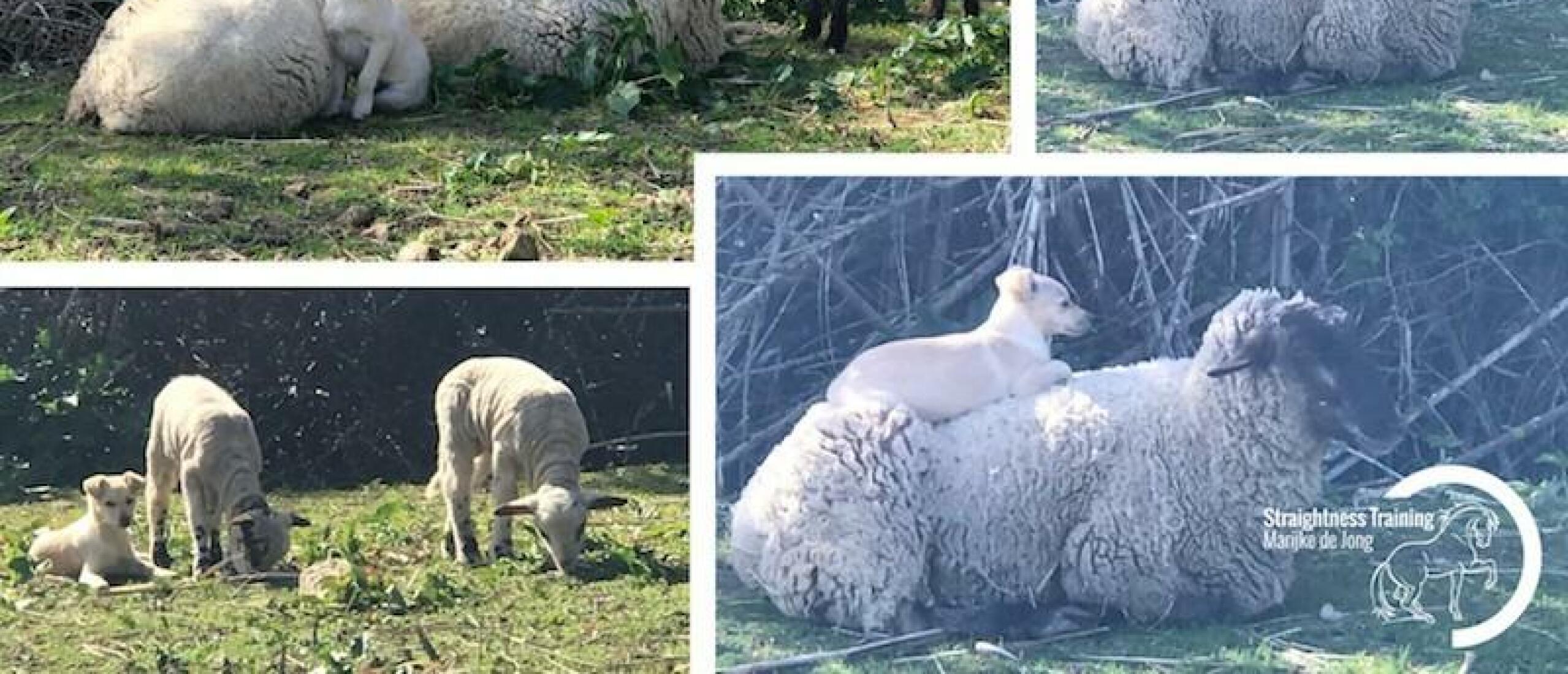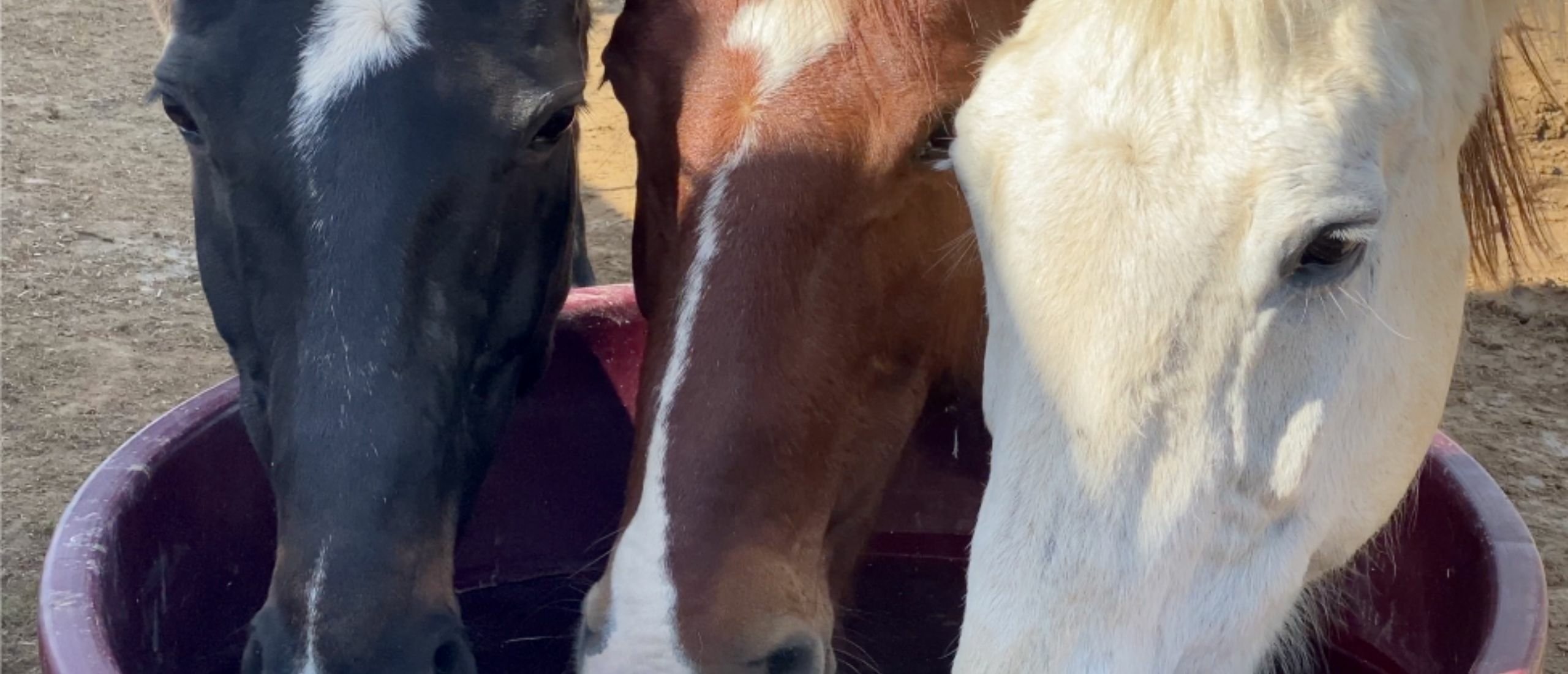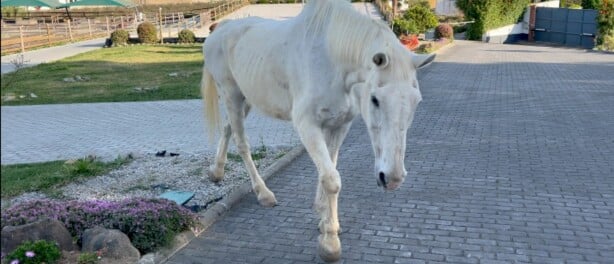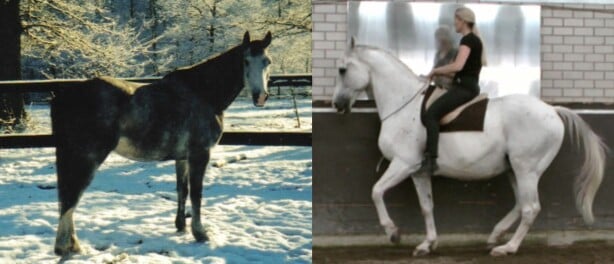In the previous video, Wolfee was 5 weeks old, and in this picture she’s 11 weeks old:

A few days before we took this picture, her mother and brother were rehomed, and also the horse went to another place. So Wolfee started to hang out and bond with the family of sheep. The good thing was that she was totally accepted and fully integrated. One sheep, who had two babies of herself, allowed her to drink, she played a lot with a young buck, the weather was beautiful, so Wolfee was doing quite okay:
Of course, it’s lovely to watch young puppies move and play, but it's also fascinating to observe Mother Nature’s laboratory where a predator is raised by prey animals.
Raising Wolfee
We observed Wolfee and the sheep for a couple of days, and it was interesting to see the way they managed to solve little issues with each other quickly and cleanly. See, for example, the first minute 15 seconds of the video, where her favorite-friend-to-play-with – the little buck – tries to avoid Wolfee’s actions and uses a sort of avoidance strategy.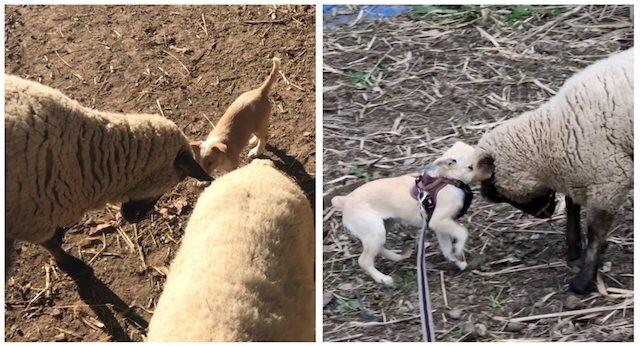 Now at other times, the buck or one of the other sheep, gave her a head butt in different degrees of severity to teach her the rules of the game. Also, the other sheep redirected her if necessary to give her structure, and to show her the boundaries and limitations. (On the picture to the left, her brother gets a "warning" head butt not to enter the sheep's space; on the picture to the right we revisited the sheep after we adopted her, but the buck told her not to greet him with too much enthusiasm). But whatever the buck and the other sheep did to raise her with manners, they all moved on to the next thing without feeling rejected or being emotionally upset over the past action.
Now at other times, the buck or one of the other sheep, gave her a head butt in different degrees of severity to teach her the rules of the game. Also, the other sheep redirected her if necessary to give her structure, and to show her the boundaries and limitations. (On the picture to the left, her brother gets a "warning" head butt not to enter the sheep's space; on the picture to the right we revisited the sheep after we adopted her, but the buck told her not to greet him with too much enthusiasm). But whatever the buck and the other sheep did to raise her with manners, they all moved on to the next thing without feeling rejected or being emotionally upset over the past action.

Hanging Out
Another thing Mother Nature shows is the value of hanging out together as predator and prey animals, and the importance of just sharing space and life. This organically creates a strong bond, and it builds trust and togetherness.
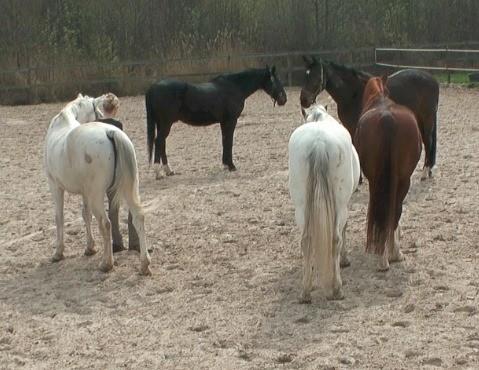
This is why a very important exercise in Straightness Training is called “hanging out”. This exercise is all about just hanging out together with our horses by sharing space and life to strengthen the relationship. So before we start any kind of training, we just hang out with our horse in the field or paddock and do nothing. We act like a human “being” – not as a human “doing” – which means we don’t ask anything from our horse and just “be” together with our horse. This increases the chances that our horse sees us as a fun and trustworthy place to be.
In-born Curiousity & Synchronicity
Mother Nature also shows the playfulness and curiosity of a young animal, and the natural ability and willingness of a youngster to follow and synchronize. 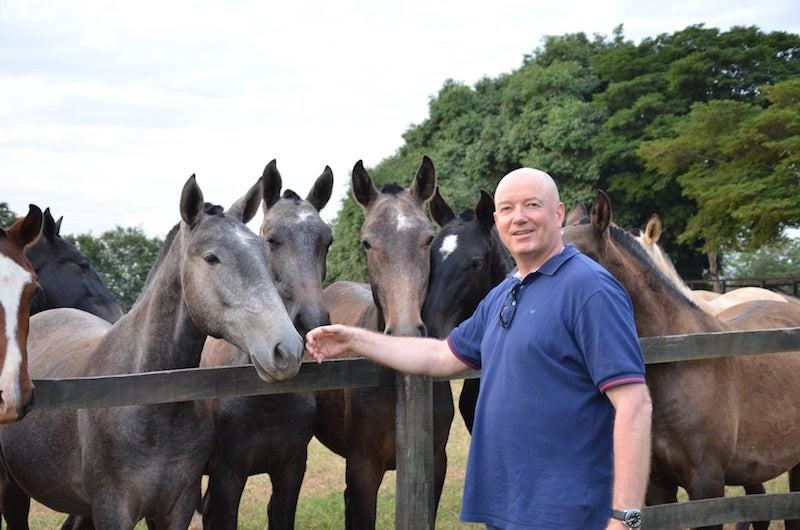 All young animals are curious, interested, and their brains love new to explore new things and new experiences. (On the picture, you see Marc and a group of curious 2 year-old Lusitano stallions.) So if a young horse finds what you are doing entertaining, and he’s interested in you, he naturally wants to be a part of it. When the learning experience and the figuring out is an organical and fun process, the outcome will be a deeper bond between you and your horse. In the fun process, your horse wants to be with you and want to do what you want. No food rewards are required since your horse is eager to do things for you as the exploring is a reward in itself since the young horse’s brains crave new experiences. Besides that, all young animals naturally follow and accompany without being told. So Wolfee followed the sheep without being trained to do so. They didn’t have to reward her with food every time she followed – she wanted to follow and join up.
All young animals are curious, interested, and their brains love new to explore new things and new experiences. (On the picture, you see Marc and a group of curious 2 year-old Lusitano stallions.) So if a young horse finds what you are doing entertaining, and he’s interested in you, he naturally wants to be a part of it. When the learning experience and the figuring out is an organical and fun process, the outcome will be a deeper bond between you and your horse. In the fun process, your horse wants to be with you and want to do what you want. No food rewards are required since your horse is eager to do things for you as the exploring is a reward in itself since the young horse’s brains crave new experiences. Besides that, all young animals naturally follow and accompany without being told. So Wolfee followed the sheep without being trained to do so. They didn’t have to reward her with food every time she followed – she wanted to follow and join up.
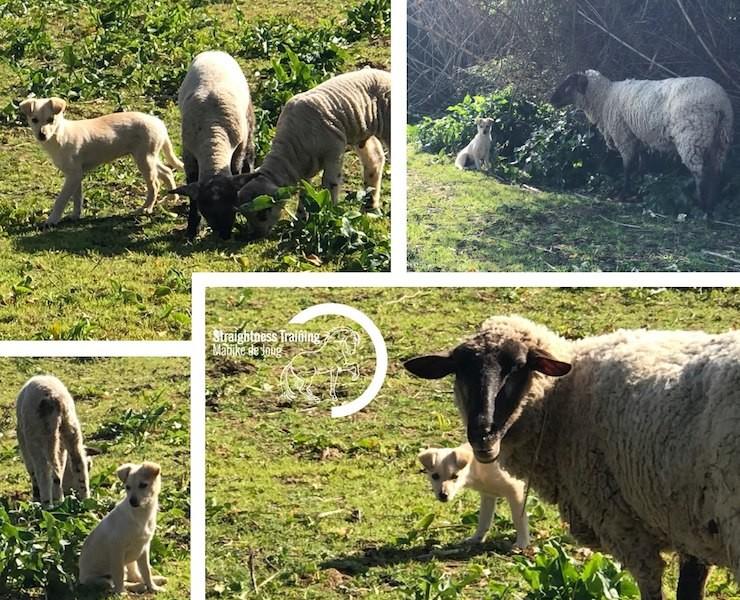
In general, no animal is born in an opposed state, no youngster is unwilling, lazy, stubborn, obstinate, angry, vicious, non-responsive or resistant. It’s the people who create vices by either using too much, too long, too often, steady, sudden pressure and lack of patience, or by loving animals to death and lack of structure. Horses who have those vices we quickly call "problem" horses and let's have a quick look at that phenomenon:
Hard To Ride & Hard To Reach
Riders don’t usually come to Straightness Training (ST) when their youngster won’t do a certain exercise. They are in need of help when their grown-up horse has a "problem" and is out of balance: Their matured horse is hard to ride physically seen, and hard to reach psychologically seen. Often, ST is their “last chance”. Now, most of the time, a lack of understanding is the root of all problems: Riders either work against Mother Nature, or they are not aware of the science of animal training, or both.  Because of misunderstanding a horse quickly drops down to the level of non-responsiveness, or can even go below zero – ending up resistant. Now ST can help people to get their horse back to the level of synchronicity. This is done by rehabilitating the horse through understanding, so he can find his way back to responsiveness, his searching state and his interest to figure things out. Once the horse is rehabilitated, he will give us his Best Aikido again and start to synchronize with us. But it’s important to realize that horses don’t have to be “trained” to the level of synchronicity as it’s already there – it’s an in-born quality. We should just be careful not to ruin it! As horses easily drop down in mental state when misunderstanding enters the learning process. Most of the time, it’s our own behavior that is contributing to and fueling our horse’s “problem” behavior. So our horse simply has to rehabilitate, it's us who need "training" how to guide that process.
Because of misunderstanding a horse quickly drops down to the level of non-responsiveness, or can even go below zero – ending up resistant. Now ST can help people to get their horse back to the level of synchronicity. This is done by rehabilitating the horse through understanding, so he can find his way back to responsiveness, his searching state and his interest to figure things out. Once the horse is rehabilitated, he will give us his Best Aikido again and start to synchronize with us. But it’s important to realize that horses don’t have to be “trained” to the level of synchronicity as it’s already there – it’s an in-born quality. We should just be careful not to ruin it! As horses easily drop down in mental state when misunderstanding enters the learning process. Most of the time, it’s our own behavior that is contributing to and fueling our horse’s “problem” behavior. So our horse simply has to rehabilitate, it's us who need "training" how to guide that process.  In ST, we speak about “It’s Always Me“ since it’s the people who usually need the most training to optimize the human-horse interaction. ST helps us to see that everything we do – often, things we ourselves are unaware of – influence the way our horse behaves. And yes, it’s not always easy to look in the mirror, and to admit “It’s Always Me – I Am The Problem – I Need To Change”. And this not only applies to horse-human interactions, but also to dog-human relationships. So after having said all this: Back to Wolfee!
In ST, we speak about “It’s Always Me“ since it’s the people who usually need the most training to optimize the human-horse interaction. ST helps us to see that everything we do – often, things we ourselves are unaware of – influence the way our horse behaves. And yes, it’s not always easy to look in the mirror, and to admit “It’s Always Me – I Am The Problem – I Need To Change”. And this not only applies to horse-human interactions, but also to dog-human relationships. So after having said all this: Back to Wolfee! 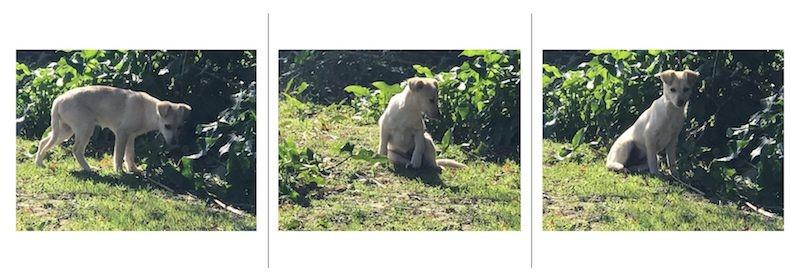
Adopting Wolfee
Although Wolfee had a good time with the sheep, we worried a bit about her future. As there are already way too many dogs without a home in Portugal, leaving her alone would not be a constructive option: This would only lead to more dogs, as Wolfee is a female dog. So we decided to adopt her. To be able to do so and to catch her, we had to create a bond first, and more about that in the next video.

